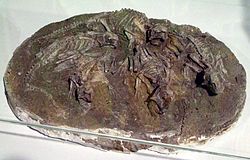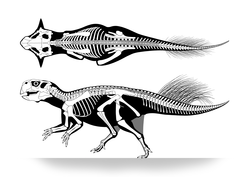Psittacosaurus
Psittacosaurus Media
Holotype of P. mongoliensis (specimen AMNH 6254), American Museum of Natural History
P. mongoliensis AMNH 6253, the "Protiguanodon" holotype. Note the presence of gastroliths.
Type skull of P. mongoliensis from Osborn, 1923
P. meileyingensis fossil, Copenhagen Zoological Museum
| Psittacosaurus Temporal range: Lower Cretaceous
| |
|---|---|

| |
| Scientific classification | |
| Kingdom: | |
| Class: | |
| Superorder: | |
| Order: | |
| Suborder: | |
| Infraorder: | |
| Family: | |
| Genus: | Psittacosaurus Osborn, 1923
|
Psittacosaurus was a small ceratopsian dinosaur from the Lower Cretaceous. It lived in what is now Asia, about 130 to 100 million years ago. It was more basal than other members of the Ceratopsia: it was bipedal, and had no horns or frill on its head. What made it a ceratopsian was its beak.
It is the most species-rich dinosaur genus, but there is no general agreement on these species. Nine to eleven species are named for fossils found in different regions of China, Mongolia and Russia, with a possible additional species from Thailand.
All species of Psittacosaurus were gazelle-sized bipedal herbivores with a high, powerful beak on the upper jaw. At least one species had long, quill-like structures on its tail and lower back, possibly with a display function. Psittacosaurs were early ceratopsians. They developed adaptations of their own, but they also shared features with later ceratopsians, such as Protoceratops and the elephant-sized Triceratops.









